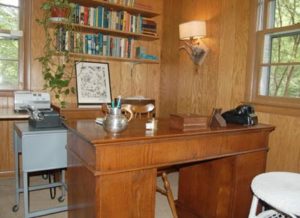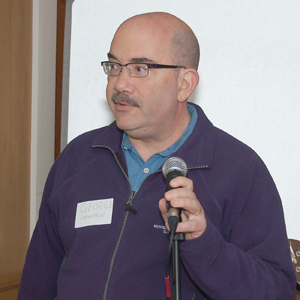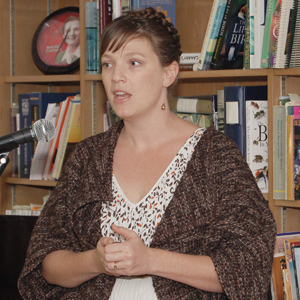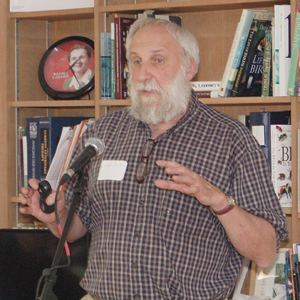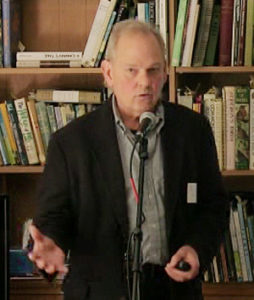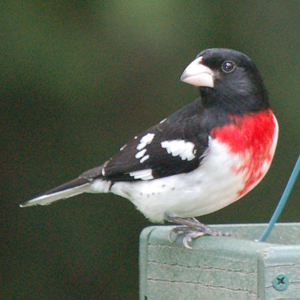May 7, 2016
Introduction
The 2016 Rachel Carson Open House took place on several different levels. Indoors there were informative presentations by 3 outstanding speakers, poetry readings and a music performance in one room, a table for creative intergenerational artwork was located in another, and there was the new historic exhibit in the corner of Rachel Carson’s study bearing a striking resemblance to photos taken in the 1960s. Organic refreshments were available in the dining room and kitchen. Outdoors there was a native plant sale and the new pollinator garden to draw visitors’ attention.
Our report on this 2016 Open House consists of two sections. Part 1 First Look introduces the topics covered by our 3 speakers. Part 2 Second Look provides additional material from our speakers as well as their conclusions and details about other remarkable aspects of that unforgettable day.
The underlying theme of the 2016 Open House was “Birds In Our Lives”
Part 1-First Look
Our 2016 Open House with its full roster of presentations, music and poetry was just starting when unexpectedly George Leventhal a Member of the Montgomery County Council, (Maryland) arrived and asked permission to briefly address the group. Councilmember Leventhal was the original supporter of Montgomery County Bill 52-14 which resulted in the ban on hazardous chemical pesticides for cosmetic use on residential lawns in the County. The ban is scheduled to go into effect on January 1, 2018.
Councilmember Leventhal spoke of being inspired by Rachel Carson in his position as a legislator in Montgomery County, Maryland where Carson also lived and where she wrote Silent Spring. He mentioned that the ban on chemical pesticides for cosmetic use on lawns in Montgomery County passed in 2015 is the strongest protection against hazardous pesticides of any large local government in the U.S.
The program formally began with our first speaker
Dr. Rhiannon Crain, the dynamic young director of the “YardMap” Project at the Cornell Lab of Ornithology and a specialist in science education. Dr. Crain discussed her plan for improving wild bird habitats with an exuberant, up to date, compelling message designed to reach folks of all ages. Her goal is to put in place a means of exchanging with horticulturists, gardeners and home owners across the country, bird-friendly, regionally-appropriate landscaping information (for Marylanders this means the mid-Atlantic region). Ultimately she envisions a modern digital “band of birders” with residents/members taking steps in their own regions while remaining aware of how they fit into a nationwide community that not only tracks and identifies birds but also assists in the strengthening and recovery of bird populations now in decline — through improving their habitat. This community of bird enthusiasts would be thinking globally and planting[1] locally. Dr. Crain’s methods of bringing this about will be detailed in Part 2 (Second Look)
Dr. Stuart Porter a retired veterinarian with experience in caring for and rehabilitating wild birds and in teaching at the College level was our second speaker. He described the common threats to wild birds as coming from toxic substances – including chemical pesticides and lead pellets, serious infectious diseases frequently found where wild birds congregate, man-made structures that interfere with bird migrations, moving object hazards as well as outdoor cats and other creatures that prey on birds. He referred to scientific data documenting these hazards and spoke effectively from his personal experience augmented by that of his colleagues in dealing with sick and injured birds under veterinary care. He brought out the fact that toxic chemicals may be contributing to many other health problems in birds through causing behavioral changes that lessen birds’ alertness and awareness, thereby increasing their vulnerability to injury from flying into cars and other objects as well as a greater susceptibility to disease. Birds that were hit by cars in his experience frequently were also carrying body burdens of pesticides and other toxics. He said that there was evidence that the immune function in birds could be depressed due to toxic chemical exposure increasing their likelihood of lacking protection from infectious diseases such as bird cholera, salmonella, or avian influenza. How ordinary people who care about birds can help will be featured in Part 2 (Second Look)
The final speaker Bill Berry, has worked as a journalist and a writer during the past 40 years, focusing on conservation and the environment, mostly from his home in Stevens Point, Wisconsin. His outstanding book, Banning DDT: How Citizen Activists in Wisconsin Led the Way (2014) served as the backdrop for his presentation. Speaking with enthusiasm, skill and familiarity with his subject Bill Berry took his audience back to the late 1960s. He wove a tapestry peopled by fascinating characters: scientists, gardeners, reporters, lawyers, and businessmen, all of whom were immersed in breaking new ground, to demonstrate the need for countering the dangers posed by DDT especially to birds such as robins, Peregrine falcons and Bald eagles. They also uncovered evidence that DDT was in virtually all the rivers of Wisconsin and maintained this was detrimental to the state’s economy, to its wildlife including birds, and to its people. These citizen activists organized their efforts, sacrificed time, donated funds to help prepare and support testimony at an Administrative Law Hearing that stretched from December 1968 until May 1969. And they were ultimately victorious. Bill Berry further stated that the citizens’ effort would not have come together as it did without the guidance of Rachel Carson’s Silent Spring. More about the value of this story today in Part 2 (Second Look)
And finally…
Those present inside the Carson House on May 7th heard three exceptionally good lectures with information related to birds, gardening, toxicology and history while those who ventured outdoors (where they also could hear the program through an audio system) had the additional treat of observing two feathered guests migrating north from South America, the rarely-seen Rose-breasted Grosbeak male and female taking seeds from our feeder during the event.
Given this remarkable coincidence and considering the day’s events, it is not too much of an exaggeration to describe our May 7th Open House in Shakespearean (Henry V) terms by borrowing from (and altering) King Harry’s speech on St. Crispin Day.
“[Folk who were elsewhere], shall think themselves accurs’d they were not here.”
[1] To provide appropriate bird habitat

